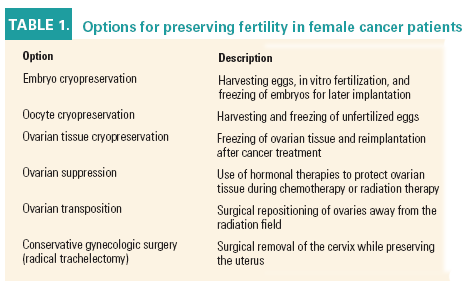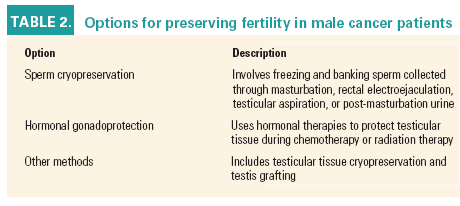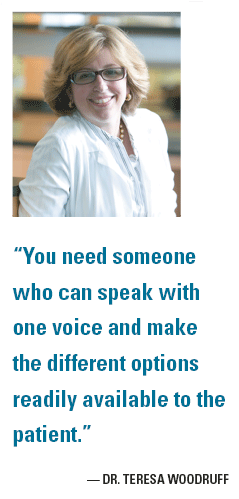Oncologists must make time for fertility issues
Putting fertility issues on the back burner should no longer be an option for oncologists who treat young adult cancer patients, especially as newer fertility preservation options become available, a number of reproductive medicine specialists told ONI.
Putting fertility issues on the back burner should no longer be an option for oncologists who treat young adult cancer patients, especially as newer fertility preservation options become available, a number of reproductive medicine specialists told ONI.
Fertility preservation is a complex issue, especially given how quickly reproductive medicine is evolving. Experts in the field have ramped up efforts to bridge the gap between cancer care professionals and fertility specialists, even proposing the creation of a new subspecialty called oncofertility. [See poll question on page 2 and on www.cancernetwork.com.]
No time for fertility
In 2002, Leslie Schover, PhD, professor of behavioral science at M.D. Anderson Cancer Center, and her colleagues conducted a survey of oncologists’ attitudes toward sperm banking before cancer treatment. Cancer specialists at M.D. Anderson and the Cleveland Clinic participated.
According to the results, nearly all of those surveyed agreed that sperm banking should be offered to all eligible men. But only 10% of the respondents reported actually doing so. The most common reasons for not discussing sperm banking included the presence of advanced disease that required immediate treatment, patients with a poor prognosis of survival, and a lack of time in a busy practice.
While Dr. Schover’s group acknowledged that the study was small and the response rate to their survey was low, they believe it still reflects “oncologists’ failure to give cancer-related infertility adequate consideration…physicians perceive the most common barriers to sperm banking to be a lack of time.”
In addition, they said, “men who have very aggressive disease…are also apt to be excluded from discussion of sperm banking…however, our knowledge test suggests that many oncologists are unaware that sperm banking no longer has to delay cancer treatment for more than few hours” (J Clin Oncol 20:1890-1897, 2002).
In a related survey of 201 male cancer patients, age 14 to 40, only a little over half (51%) said that a healthcare professional mentioned sperm banking before they underwent treatment that could compromise their fertility. On the upside, 41% of the patients who did know about sperm banking obtained the information from their oncologists (J Clin Oncol 20:1880-1890, 2002).
Two years later, not much had changed. In 2004, the Fertile Hope foundation conducted a series of focus group sessions with oncologists, oncology nurses, and oncology social workers.
“Timing was a major concern raised by the oncologists,” said Joyce Reinecke, vice president of programs at New York-based Fertile Hope. “I think there is an immediate reaction on the part of oncologists that they don’t want fertility issues to interfere with their optimal treatment timeline.”
More recent surveys of breast cancer specialists show that oncologists have good intentions when it comes to fertility issues, but don’t necessarily see them through. In a survey of 91 oncologists at Duke University Medical Center, 61% said they usually discussed the impact treatment will have on their patients’ fertility.
But the discussion did not necessarily lead to action: Only 15% of those surveyed said they routinely referred younger breast cancer patients to reproductive specialists. The results were reported in a poster at the 2007 American Society of Reproductive Medicine meeting (abstract P-690).
Another survey from Canada yielded similar results, with less than half of 395 respondents saying they regularly discuss fertility preservation with female cancer patients and only 7% stating that their treatment center has a policy to refer these patients to reproductive specialists (ASRM abstract P-703).
Closing the ‘teen gap’
The Children’s Oncology Group (COG) is forging ahead with research on younger cancer patients. Their long-term goal is to corral enough young patients into clinical trials and gain a better understanding of the unique needs of this population. Ultimately, COG aims to close the “teen gap” that occurs as adolescent cancer patients move out of the academic pediatric oncology setting for treatment with adult oncologists in private practice.
“The majority of patients diagnosed with cancer before the age of 15 are managed by a pediatric oncology academic center that is a member of COG,” said
Smita Bhatia, MD, MPH, chair of COG’s late effects committee and associate director of population research at the City of Hope Comprehensive Cancer Center. However, she pointed out, those diagnosed during their late teens or early 20s are more likely to be managed by a non-pediatric team, quite often in a nonacademic setting.
“There is a big push in COG to make protocols that extend up to 30 years of age, essentially closing that teen gap,” she said.
Increasing awareness
Other groups are doing their part to increase fertility awareness. In 2006, the American Society of Clinical Oncology and ASRM released an extensive practice guideline on survivorship and fertility preservation.
The guideline was crafted by an expert panel that included Dr. Schover, oncologist Lawrence Brennan, MD, of Oncology/Hematology Care, Crestview Hills, Kentucky, and fertility specialist Kutluk Oktay, MD, of New York Medical College, Valhalla.
Dr. Schover said that her group has produced an educational CD, “Banking on Fatherhood,” funded by the National Cancer Institute. It includes a section for healthcare professionals that outlines the importance of sperm banking and a directory of US-based sperm banks.
Fertile Hope has begun a program specifically to reach out to cancer care specialists, Ms. Reinecke said. One of their aims is to encourage oncology professionals to understand the distinction between fertility preservation and infertility treatment.
“During the focus groups, a lot of the doctors expressed limited knowledge about fertility treatment,” Ms. Reinecke said. “They would say things like ‘My sister-in-law did in vitro fertilization and it took 9 months to get pregnant. So this is not something that I can talk to my patients about.’ They were looking at the patients as already having fertility problems.”
Sorting out the options
Of course, fertility preservation is not a cut-and-dried matter, Dr. Bhatia pointed out. Options will vary depending on patient gender, age, disease state, disease stage, co-morbidities, and cost (see Tables 1 and 2). In men, for example, sperm banking may only delay treatment by as little as one day. In women, matters are more complicated.


“The only accepted approach for women is embryo cryopreservation,” Dr. Bhatia said. Using this technique, the ovaries are stimulated with hormones for 2 weeks, after which the oocytes are harvested and fertilized in vitro, and the embryos are cryopreserved for future use.
The disadvantages of this approach, she said, are the 2-week requirement for ovarian stimulation, which can delay cancer treatment; the requirement of a partner to donate sperm; the fact that its use is limited to the postpubertal population; and the cost, which averages $8,000, with additional costs incurred annually for storage.
“Those are the challenges,” she said.
But this option and its challenges still need to be communicated to the patient when appropriate, according to fertility preservation advocates.
“The goal of Fertile Hope is to get fertility preservation information to the age-eligible patient at the point of diagnosis,” Ms. Reinecke said. “We’re not asking oncologists to become reproductive medicine specialists. We want them to understand that the younger cancer patient may not have the same issues as their standard adult patient.”
Oncofertility Consortium
Perhaps the most ambitious of the outreach efforts is the Oncofertility Consortium at Northwestern University’s Robert H. Lurie Comprehensive Cancer Center in Chicago. For Teresa Woodruff, PhD, director of the consortium, it all started with a follicle.

“My passion is to understand how ovarian follicles develop,” Dr. Woodruff told ONI. “The essential question that we wanted to answer is: How does an individual follicle make the decision to be the one that ovulates when a woman is 19 and it’s May, while the follicle sitting next to it won’t receive that signal for 10 or 20 years, during the woman’s reproductive autumn?”
A little over a decade ago, Dr. Woodruff took the reins at the basic sciences program at Northwestern, which is when her interest in ovarian biology and endocrinology met head-on with cancer treatment.
“I started thinking about the fertility of cancer patients, since the chemotherapeutics that are life preserving are also very fertility threatening,” Dr. Woodruff said. “We are challenging the notion of what basic science can do to work in partnership with cancer biologists to develop fertility preservation methods for all young people with cancer.”
The Oncofertility Consortium aspires to become an international clearinghouse for cancer care professionals and their patients on all aspects of fertility preservation. More important for clinicians, Dr. Woodruff and her colleagues are providing the nuts and bolts required to launch in-house fertility preservation programs.
“Our goal is to reduce any administrative burdens to a clinical practice that wants to offer fertility preservation. The hurdles to getting these programs established are pretty high, and we’ve already gone through that process,” Dr. Woodruff explained.
Community, academic, and private cancer treatment facilities can sign on to become part of the consortium as primary centers. These centers will then launch research and other projects in conjunction with Dr. Woodruff and the other 35 consortium primary centers.
Funded by a $21.5 million grant from the National Cancer Institute, consortium-sponsored projects run the gamut from cutting edge science, such as the pretreatment removal and cryopreservation of whole ovaries, to the creation of a reproductive educational program aimed at girls in middle school.
The consortium will conduct an interdisciplinary study that examines the social science of oncofertility. The investigators will look at cancer patients’ concerns regarding fertility, how decisions about fertility come about, and the ethical factors that influence how fertility choices are made pre-treatment.
Finally, there is the Globally Ready Scholar program, part of the consortium’s attempt to go global from the outset. This 1-year fellowship training course in oncofertility will be led by Christos
Coutifaris, MD, PhD, at the University of Pennsylvania. Scholars will have the option to train at multiple universities affiliated with the consortium.
A new subspecialty?
One of the consortium’s major aims is to spearhead development of a new healthcare professional-the oncofertility subspecialist-who steers young patients through the cancer treatment process with an eye toward their fertility needs.
At Northwestern, a fertility preservation patient navigator is now a staple, routinely guiding young female cancer patients through their reproductive health options.
“The fertility preservation issue in women bridges three disciplines: obstetrics/gynecology, urology, and oncology. I see this oncofertility specialist as being grounded in one of those three specialties,” Dr. Woodruff said. “We call them broadband spanners, the kind of person who can talk authoritatively across disciplines.”
Other experts agreed that the idea of an oncofertility patient liaison is worthwhile, although integrating this person into cancer care protocols may be easier said than done.
“The concept of a liaison is really important, but who should be that liaison?” commented Diane Yamada, MD, associate professor of gynecology/oncology, University of Chicago. “Should it be a physician? Should it be a nonphysician who is less likely to have a bias? Certainly the oncologist would have the oncology perspective, but there are so many different types of cancer: How is one oncologist going to know all the different treatment regimens and their risk for rendering a patient subfertile or infertile?”
A fertility specialist would certainly have the background and skill-set to discuss reproductive concerns with cancer patients. “But there may be a conflict of interest with this person presenting this information at a very stressful time. You have to make sure that he or she is interfacing with the oncologist,” she said.
For male fertility issues, Dr. Schover said she would like to see cancer centers develop on-site collection rooms and active referral relationships with Reproductive Endocrinology and Infertility (REI) laboratories. Urologists and andrologists with an interest in fertility issues would also be well suited as patient liaisons, she added.
Getting to the patient in time
Ms. Reineke said that oncology nurses and oncology social workers have expressed an interest to Fertile Hope in taking on a liaison role. Perhaps a more pressing issue isn’t who serves in this role, but at what stage during the treatment process they are able to bring fertility information to the patients.
I think people are ready and willing to do this, but will they get to the patient in time?” she asked. “When a cancer patient comes in with that checklist of support services, we would like to see fertility counseling on that checklist. The key is to get them before the initiation of chemotherapy.”
The reproductive endocrinologist
In Dr. Bhatia’s estimation, “the ideal individual for such a position would be a reproductive endrocrinologist.” In fact, she said, “a service consisting of a reproductive endocrinologist, along with a nurse practitioner with expertise in this area and a psychologist, would serve the needs of the patients perfectly.”
Dr. Oktay also said that a reproductive medicine specialist would be the best candidate, especially because fertility issues are not limited to cancer patients.
“Drug-induced infertility will probably be the most prominent cause of infertility in the 21st century,” Dr. Oktay said. “This is not just about cancer patients. Chemotherapy is used for many hematologic, immunologic, and idiopathic conditions.” Thus, he noted, fertility preservation requires expertise in assisted reproduction techniques as well as a sound understanding of medicine in general.
“As such, it is already becoming a subspecialty within reproductive medicine. I do not think that it can be a separate specialty,” Dr. Oktay said.
But Dr. Woodruff emphasized that the consortium is not looking to start a turf war between oncologists and reproductive medicine.
“We’ve tried to navigate so that every physician and scientist feels they are part of this in an intrinsic way. The idea is that in 10 years, patients won’t be treated the same way they are today,” she said, adding that “you need someone who can speak with one voice and make the different options readily available to the patient.”
Online resources on fertility preservation for young adult cancer patients
American Society of Clinical Oncology (ASCO) Practice
Guidelines Clinical Tools and Resources for Survivorship
www.asco.org
American Society for Reproductive Medicine (ASRM)
www.asrm.org
CureSearch/National Childhood Cancer Foundation
Children’s Oncology Group
www.curesearch.org
Fertile Hope
www.fertilehope.org
Lance Armstrong Foundation Young Adult Alliance
www.livestrong.org
Living Beyond Cancer: Finding a New Balance
President’s Cancer Panel 2003-2004 Annual Report
http://deainfo.nci.nih.gov/ADVISORY/pcp/pcp03-04rpt/Survivorship.pdf
Oncofertility Consortium
http://oncofertility.northwestern.edu/
Newsletter
Stay up to date on recent advances in the multidisciplinary approach to cancer.